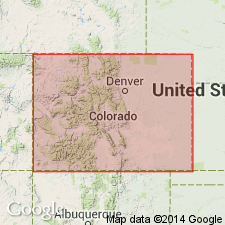
- Usage in publication:
-
- Willow Creek beds*†
- Modifications:
-
- Original reference
- Abandoned
- Dominant lithology:
-
- Conglomerate
- Shale
- Sandstone
- AAPG geologic province:
-
- Denver basin
Summary:
Pg. 86-112. [In footnote on p. 97 Eldridge withdrew "Willow Creek beds," because of preoccupation in Canada, and substituted Arapahoe.]
Willow Creek beds. Consist of 600 to 1,200 feet of gray argillaceous or arenaceous shales with lenticular masses of hard quartzose sandstone and an occasional ironstone, underlain by 200 feet of conglomerate or gritty sandstone, which may become bulk of formation, as in type locality, or may thin to merest edge, as in northern limit along Platte River near Brighton. This formation contains pebbles from every formation that lies beneath it in Denver field, as well as from others far beyond, especially the Carboniferous. Unconformably overlies Laramie formation and unconformably underlies Denver beds, described by Cross. Contains dinosaur remains. Named for Willow Creek, in southern part ot field, 1 to 3 miles southeast of mouth of Platte Canyon [Denver basin, eastern Colorado], where it has its greatest and most typical development. [Age is Late Cretaceous.]
Source: GNU records (USGS DDS-6; Denver GNULEX).
For more information, please contact Nancy Stamm, Geologic Names Committee Secretary.
Asterisk (*) indicates published by U.S. Geological Survey authors.
"No current usage" (†) implies that a name has been abandoned or has fallen into disuse. Former usage and, if known, replacement name given in parentheses ( ).
Slash (/) indicates name conflicts with nomenclatural guidelines (CSN, 1933; ACSN, 1961, 1970; NACSN, 1983, 2005, 2021). May be explained within brackets ([ ]).

